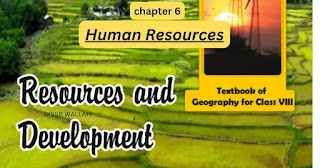Chapter 6
Human Resources
1. Answer the following questions.
(i) Why are people considered a resource?
Ans:People are the most important resource of a nation. All other resources become meaningful when people use them. Human resource is the ultimate resource because it is people with their needs and abilities that make resources valuable.
(ii) What are the causes for the uneven distribution of population in the world?
Ans:Population distribution in the world is uneven due to two main factors: Geographical and Social.
Geographical factors:
1. Topography: People tend to live in plains as they are suitable for farming, manufacturing, and services. Mountains and plateaus like the Andes, Alps, and Himalayas have lower populations.
2. Water: Areas with easy access to fresh water, such as river valleys, are more densely populated, while deserts have lower populations.
Social factors:
1. Social: Regions with better housing, education, and healthcare facilities attract more people, leading to higher population densities. For example, Pune.
2. Economic: Industrial areas with employment opportunities draw a large number of people, resulting in dense populations. Osaka in Japan and Mumbai in India are two examples.
Overall, population distribution is influenced by a combination of geographical and social factors.
(iii) The world population has grown very rapidly. Why?
Ans:World population has increased significantly due to advancements in science and technology. Improved agriculture and healthcare have led to higher food production and reduced death rates.
(iv) Discuss the role of any two factors influencing population change.
Ans:Two factors influencing population change are the birth rate and death rate. Birth rate refers to the number of births per 1,000 people, while death rate indicates the number of deaths per 1,000 people. The difference between the birth rate and death rate is known as the natural growth rate. If the birth rate exceeds the death rate, the population increases, and vice versa.
(v) What is meant by population composition?
Ans:Population composition refers to the structure of the population, including details about gender, age groups, education levels, occupations, income levels, and health conditions. The population pyramid, also known as an age-sex pyramid, is an interesting tool to study population composition in a country. It helps visualize the distribution of age and gender groups within the population.
(vi) What are population pyramids? How do they help in understanding the population of a country?
Ans:The graphical representation used to study the composition of a country’s population is called the population pyramid. It shows the total population divided into various age groups, the percentage of the total population subdivided into males and females and the number of dependents in a country. When the population of a country has high birth and death rates, the population pyramid is broad at the base and narrow towards the top.
2. Tick the correct answer.
(i) What does the term ‘population distribution’ refer to?
(a) How the population in a specified area changes over time.
(b) The number of people who die in relation to the number of people born in a specified area.
(c) The way in which people are spread across a given area.
(ii) Which are the three main factors that cause population change?
(a) Births, deaths and marriage
(b) Births, deaths and migration
(c) Births, deaths and life expectancy
(iii) In 1999, the world population reached
(a) 1 billion
(b) 3 billion
(c) 6 billion
(iv) What is a population pyramid?
(a) A graphical presentation of the age-sex composition of a population.
(b) When the population density of an area is so high that people live in tall buildings.
(c) Pattern of population distribution in large urban areas.
3. Complete the sentences below using some of the following words.
(sparsely, favourable, fallow, artificial, fertile, natural, extreme, densely)
When people are attracted to an area, it becomes ………………….. populated. Factors that influence this include ………………….. climate, good supplies of ………………….. resources and ………………….. land.
Answer: When people are attracted to an area, it becomes densely populated. Factors that influence this include favourable climate, good supplies of natural resources and fertile land

